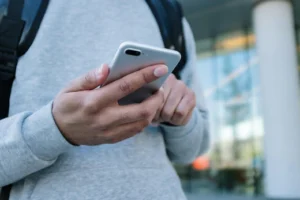- – SAR a measure of the amount of RF (radio frequency) absorbed by tissues in our body whenever some radiation is transmitted
-
– In the US, the SAR limit was set in 1993
-
– SAR only focuses on the head instead of other parts of the body that may also be exposed to radiation
-
– SAR is a measurement focused on the heating of the tissue, which is not as relevant when we look at the bigger picture
In previous blogs, we’ve really explored EMFs (Electromagnetic Fields) and the radiation emitted by devices we use every day in detail. But what about the specifics? How much radiation do we actually absorb when using our phones, laptops, or other devices that surround us?
That’s where the Specific Absorption Rate or SAR comes in. It’s a measure of the amount of RF (radio frequency) absorbed by tissues in our body whenever some radiation is transmitted. It’s normally measured using watts per kg (W/kg) and can be used to assess the maximum possible exposure to RF energy from a particular cell phone model. The FCC conducts SAR testing to establish standards that all devices have to be less than to pass.
SAR has been used as the main measurement for regulatory bodies across the globe to set safety limits on electronic devices, however, this measurement only really matters when the device is close to the body. It does not account for the long-term effects and compounding impacts of constant, surrounding exposure to RF-EMF.
But how exactly is SAR tested? According to the FCC, testing uses specific models of the human head & body (dummy) that are filled with liquids to mimic the effect of EMF exposure on human tissue. SAR levels are always tested using the maximum with the aim to find the highest exposure level and its corresponding SAR level. The FCC and other government institutions define it using an average 30 min phone call with the device held right next to the ear. Note the way you use your device (the distance in between, how long you use it for, whether or not you use calls or texts more, etc.) will change the specific effects.
Now that we know what SAR is, we can go into detail about why it may not be the most reliable or accurate measure.
In the US, the SAR limit was set in 1993 when mobile phones were only used for a couple of minutes a day – suggesting that it’s currently very out of date and may not be as effective for devices today. Many scientists now express that although SAR is important, it’s not the most effective measure because, in reality, SAR is about the amount of radiation absorbed by a test dummy (never tested on a human before) and less about how much radiation is emitted by a device specifically. The size of the dummy’s head was also actually taken from a military recruit – a size that is only applicable to less than 3% of the population. Also, since the study was based on an adult head, it would be inaccurate to assume it’s the same for children who absorb twice the radiation that adults do. This already implies that extrapolation to the larger population is not possible.
Additionally, since it only focuses on the effects of heating the tissue, it fails to recognize the effects on other biological systems within the body – which we’ve gone into depth before, including Oxidative Stress and other physiological effects.
Although we’ve compared the SAR levels of different devices before, that one single value doesn’t properly differentiate between the models due to several reasons/discrepancies. For instance, one cell phone (CP) might operate more efficiently so it works at a lower power than another CP under comparable situations so the user would somehow absorb more RF energy. There are many other small changes that mean that the value is not a standardized measure to be generalized across all devices.
Essentially, SAR is more to do with the heating of the tissue, which is important, but does not cover the entire picture. Besides, most if not all devices on the market meet the FCC’s standards and SAR limits. For those that are concerned with the measure’s ineffectiveness, it would be recommended to take extra precautions like keeping your phone away from you when you can, turning off Wi-Fi when not in use, and being mindful and intentional with your technology usage.
Fun fact: On your iPhone, if you go to Settings > General > Legal & Regulatory > RF Exposure, you’ll see whether your device meets the requirements and more info!








